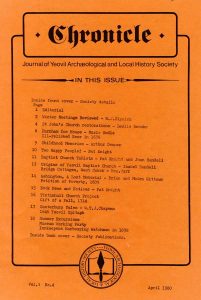1980-Apr-pg17_Canterbury Tales
This article came from Chronicle published April 1980. Page: 17
CANTERBURY TALES
Author: W.T.J.Chapman
During the summer of 1979 I spent some time studying the pilgrimage routes to Canterbury. The route I was particularly interested in was that from Winchester and the West. Parts of this study involved travelling the route and visiting places frequented by the pilgrims on their way to the shrine of St Thomas à Becket.
With my family we commenced our journey at the hospital of St Cross, Winchester, where we received the Wayfarer’s Dole of bread and beer, now such a tradition at St Cross and derived from Bishop de Blois’ desire to provide food and drink for one hundred poor men daily. Today it is but a gesture to the founder’s ideal. It is nearly 850 years since Henry de Blois, grandson of William the Conqueror and brother of King Stephen, conceived the idea of providing a permanent home for thirteen men too poor and too weak to fend for themselves, and to this he added the thought that the ‘home’ should daily provide dinner for one hundred poor men.
From St Cross, our pilgrimage took us by way of Winchester and the Cathedral, and then on to Farnham, Guildford, Maidstone, Charing, Chilham, and so to Canterbury. It was a most interesting experience following the footsteps of those medieval pilgrims, and one was conscious of how many traditions and customs survive today that relate to the period when pilgrimages were at their zenith. The Wayfarer’s Dole at St Cross was one of those traditions and another was the visiting of holy places along the pilgrims’ route.
Coming from, the West Country, pilgrims might well have visited the large church of St Candida and Holy Cross at Whitchurch Canonicorum in the heart of Marshwood Vale, near the coast between Lyme Regis and Bridport. This parish church is unique in Britain in possessing the relics of its patron saint, St Candida, or Wite, in a thirteenth-century shrine.
The shrine of St Wite is built into the wall beneath the north window of the north transept and consists of two parts: the lower section of early 13th century work forming the supporting base for the upper section which is a stone coffin with Purbeck marble top containing the relics of St Wite. Beneath are three oval openings intended for the insertion of diseased limbs or for handkerchiefs to be afterwards borne away for the healing of the sick. Prayers written on pieces of paper placed in these openings, seen when we visited the church, are evidence that this shrine is still a place of pilgrimage today.
Space will not permit the sharing with you of all the experiences by family and I shared on our pilgrimage, however, there are two thins that we will long remember. Firstly the majestic sight of Canterbury Cathedral, and secondly the little prayer written by one visitor to the shrine of St Wite on behalf of her sick baby, with one of the child’s socks attached to the card on which the prayer was written.
